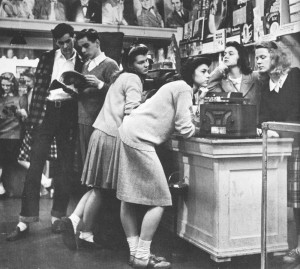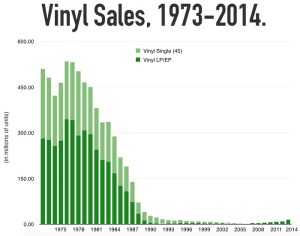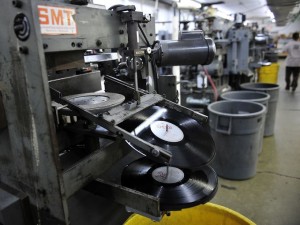It has been said that fashion is a relentless cycle in which the trends of earlier generations are set to return with both its original charm accompanied with a modern twist. However, just as we are now seeing the billowing bellbottoms of the 70s reemerge back on our fashion runways so is another forgotten treasure belonging to a different trade: vinyl records.
Vinyl records and turntables can be spotted almost anywhere nowadays. From retailers such as your local Target or Best Buy to Urban Outfitters LPs are reappearing on the shelves of various stores across the United States. No longer do vinyl enthusiasts have to search far and wide for an indie music retailer to purchase a copy of their favorite record.
The cyclical path that fashion undertakes may seem rational for the respective industry because there are only a limited number of ways a pair of denim jeans can be redesigned, however, the technology field on the other hand has made tremendous advancements within this past decade alone that has in turn revolutionized the music industry.
Vinyl records pioneered the at-home listening experience and remained on top for nearly 50 years after being introduced in 1898 by RCA Victor. Records were originally launched as “program transcription” discs and initially varied in size between 10 and 12 inches in diameter.
Yet, it was assumed that vinyl was a long forgotten medium by mainstream consumers as it fell from cultural popularity in the 1960s alongside the introduction of cassettes. Cassettes replaced our beloved records and turntables, and were later substituted with compact discs (CDs) and Walkman’s. But it was MP3s and MP3 players, such as Apple’s IPod and Microsoft’s Zune, which ultimately superseded CDs. Undoubtedly; MP3s transformed the music industry and drove the business towards the digital realm, whereas vinyl became an ancient relic that remained exclusive to only a small niche of individuals whom were deemed vinyl collectors.
Digital media has produced both positive and negative outcomes for the music industry. Digital tracks and streaming have allowed artists to expand and grow, whereas it has also eased the ability for music to be shared at a greater volume and speed than ever before. However, digital media has also facilitated the risk of piracy within the music industry and has subsequently caused an excessive loss of revenue for the business.
While piracy remains a looming issue that artists and record companies continue to combat it has also affected the U.S. economic market. The institute for Policy Innovations has revealed that universal music piracy causes approximately $12.5 billion dollars of financial losses every year and cuts 71,060 U.S. domestic jobs. Additionally, it also creates a loss of $2.7 billion dollars in workers’ total earnings, and causes a loss of $422 million dollars in tax revenues annually.
Unfortunately, the digital age has made purchasing music less than necessary in today’s market. Digital and physical album sales have declined tremendously in recent years. After selling approximately 165 million CDs in 2013, the total number of album sales has dropped 14 percent to 140 million by the end of 2014. Furthermore, digital sales through platforms, such as ITunes, have fallen 9.4 percent as reported by its 2014 sales figures.
Statistics company Nielsen Music, which observes and records album and song sales and streams, has disclosed that mass market and chain music stores, such as FYE, have reported that their total music sales have declined roughly 20 percent by the end of 2014.
“Music fans continue to consume music through on-demand streaming services at record levels, helping to offset some of the weakness that we see in sales,” said David Bakula, Nielsen’s Senior Vice President of Industry Insights. “The continued expansion of digital music consumption is encouraging, as is the continued record setting growth that we are seeing in vinyl LP sales.”
Still, it has been observed that the vinyl revival movement has gained incredible momentum. The demand and popularity of vinyl has become an exciting music industry trend for artists and record companies. It has been noted that the 12-inch record sold roughly 9.2 million entities in 2014, which has been the highest amount of units sold in decades. Vinyl’s 2014 sales figure is over a 50 percent increase above its 2013 numbers, which has become a trend that has been observed within the vinyl market for nearly the past four years. A decade ago vinyl sales accounted for only 0.2 percent of the total number of albums sold, but record sales now make up roughly six percent of all physical music sales.
It is no secret that the music industry and its original business model has been flipped upside down and transformed throughout the 21st century. Upon the dawn of the digital age, CD sales began plunging at an alarming rate and large chain music stores, such as Tower Records, became unable to keep up with the shift and were forced to file for bankruptcy.
Similarly, when the demand for vinyl records waned in the 1980s companies began pressing fewer LPs. Therefore; in accordance to the economic law of supply and demand retailers began to cut its inventory of records and the audio equipment that would accompany the music format. Eventually most local retailers completely rid itself of the medium.
Even specific music genres that were eminent in the vinyl industry began to abandon vinyl discs. Jazz was recognized as a longtime forerunner in the vinyl industry as it was one of the first genres of music to appear on a vinyl record and released commercially to the public. The first Jazz recording was Livery Stable Blues by the Original Dixieland Jass Band in 1917.
However, with the comeback of the vinyl industry, many individuals and artists are swiftly jumping on the vinyl bandwagon.
It has been observed that traditional record stores are quickly reemerging in the United States, and vinyl record pressing plants have seen a significant spike in record orders and production overall. New vinyl pressing factories have also began appearing alongside the few plants that have sustained business since golden age of the vinyl era. It is estimated that smaller sized pressing plants are producing and receiving orders for at least 450,000 units per year, whereas larger factories are turning out around 7 million annually.
The owner of Quality Record Pressings in Kansas, Chad Kassem, launched his own vinyl record-pressing factory in 2011 after he grew tired of waiting for his primary supplier to receive and complete his orders. Kassem’s business utilizes four presses in total and manufactures approximately 900,000 discs annually.
“We’ve always had more work than we could do,” Mr. Kassem said. “When we had one press, we had enough orders for two. When we had two, we had enough orders for four. We never spent a dollar on advertising, but we’ve been busy from the day we opened.”
Musicians have also recognized the new opportunities that vinyl industry provides. The number of vinyl reissues, such as albums by the Beatles and the Rolling Stones, has grown in recent years. And many new musicians have begun providing vinyl discs as an alternative option alongside digital albums and CDs.
Jack White of the White Stripes released a solo album in 2014 entitled Lazaretto set a vinyl sales record. White’s latest album sold 40,000 vinyl units its first week and 87,000 by the end of the year.
In total 2014 emerged as the greatest sales year for vinyl records in decades. The vinyl comeback was definitely unforeseen, as many believed that vinyl discs were an antiquated music medium after the introduction of new technological advancements that have produced CDs and MP3s. But the resurgence of vinyl could not have come at a better time. While the music industry has been taking major losses as a result of piracy it will be interesting to see how the new vinyl wave impacts the music industry and sales overall.
Sources:
http://www.wsj.com/articles/the-biggest-music-comeback-of-2014-vinyl-records-1418323133
http://www.rollingstone.com/music/news/streaming-vinyl-rises-amid-declining-album-sales-in-nielsens-2014-report-20150108
http://www.riaa.com/faq.php





Leave a Reply
You must be logged in to post a comment.